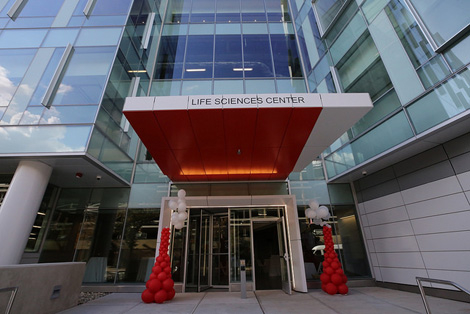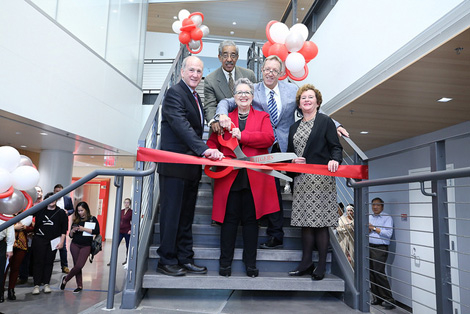A New Front Door to the Sciences at Rutgers University-Newark
Facility broadens the university’s capacity as talent pipeline for women and minorities in science and enhances support for community-based research

"LSC II fulfills a commitment to research and teaching in the sciences made at Rutgers University-Newark more than half a century ago. We make a commitmentto the future, to pass on to the next generation excellence in the sciences."- Jan Lewis,dean, FASN
Rutgers University-Newark celebrated the new Life Sciences Center (LSC II) on Thursday, November 2, with a grand opening event for the $59 million, state-of-the-art, five-story science complex located on University Avenue in downtown Newark.
"It is such a grand day," said Nancy Cantor, chancellor of Rutgers University-Newark, "and a grand facility that not only realizes the long-standing plans of the Rutgers-Newark STEM community, but it also opens so many new possibilities for our community to contribute to where Life Sciences innovation is moving going forward."
LSC II is the front door to the sciences quad, a contiguous, multi-building teaching and research complex that is home to the departments of Biological Sciences, Chemistry and Earth and Environmental Sciences and the Center for Molecular and Behavioral Neuroscience (CMBN).
The 85,000-square-foot structure gives physical reality to interdisciplinary practice in the sciences linking Life Sciences I, built in 2005; Aidekman Hall, completed in 1991 (neuroscience); Boyden Hall, completed in the 1960s (biology and environmental sciences); and Olson Hall, completed in the early 1970s (chemistry).

“The Life Sciences Center is a focal point for the vibrant science programs on campus. The remarkable transformation of science facilities at Rutgers University-Newark over the years is the realization of a decades-long dream of the science faculty to have truly state of the art laboratories for both teaching and research that exposes Rutgers-Newark undergraduates to the way modern sciences are conducted,” said John Sheridan, senior associate dean of the Faculty of Arts and Sciences-Newark (FASN). Current faculty in the sciences garner upward of $13 million in external funding for research and teaching.
"It's the knowledge spinout that drives the engine of the economy," said Robert L. Barchi, president of Rutgers University. "It's the students that are learning these new techniques, especially in the biological sciences and medical sciences that are going to stamp those new companies and lead them, and it's the combined action of both of those that really drives the economy and business of the state."
Rutgers University-Newark boasts highly regarded chemistry and psychology programs and leading programs in cell biology, ecology and evolution and environmental sciences. In addition, CMBN provides cutting-edge research in the neurosciences and has the premier research MRI facility in the northern part of the state, the Rutgers Brain Imaging Center (RUBIC) located in Aidekman Hall.
The five above-ground floors inside LSC II include: modern teaching laboratories for upper-level chemistry and biology courses; chemistry and biology research laboratories; and a 100-seat lecture hall with “smart classroom” capability, designed for active learning and student engagement. A state-of-the-art imaging and electron-microscopy facility is housed 27-feet below ground level.
LSC II will further broaden the university’s capacity to be New Jersey’s talent pipeline for first-generation, underrepresented and minority students in science and community-engaged research that has an impact in Greater Newark. “LSC II fulfills a commitment to research and teaching in the sciences made at Rutgers University-Newark more than half a century ago. We make a commitment to the future, to pass on to the next generation excellence in the sciences,” adds Jan Lewis, dean of the Faculty of Arts and Sciences.
The faculty at FASN have proven their ability to hire and mentor younger scientists in their fields.The FASN has 17 distinguished professors, the highest rank Rutgers bestows on professors, and 12 are in STEM fields. Additionally the science faculty has a Henry Rutgers Professor and a Henry Rutgers Term Chair in STEM, as well as an endowed chair in neuroscience and a distinguished service professor. About one-third of the faculty in the departments of Chemistry and Math and the Neuroscience Center are distinguished professors.
Rutgers University-Newark’s commitment and demonstrated success in training first-generation, underrepresented and minority students in STEM is further reflected in the array of longstanding funded programs.
Barry Komisaruk’s National Institutes of Health Minority Biomedical Research Support grant for minority graduate students in the biomedical sciences has been funded continuously since 1984. Alec Gates’ Louis Stokes Alliance for Minority Participation program (LSAMP), aimed at increasing the number of underrepresented students in non-medical STEM fields, has been funded continuously since 2009. The LSAMP grant has recently been supplemented by a $2.5 million grant from the National Science Foundation S-STEM, Sustainable Pathways from Community College to Bachelor's Degree for Urban Youth in STEM, Northern New Jersey. And the Academic Foundations Center recently received a $1,160,000 grant to fund the preparation for graduate study, including in STEM, of undergraduates from first-generation, underrepresented and minority groups.